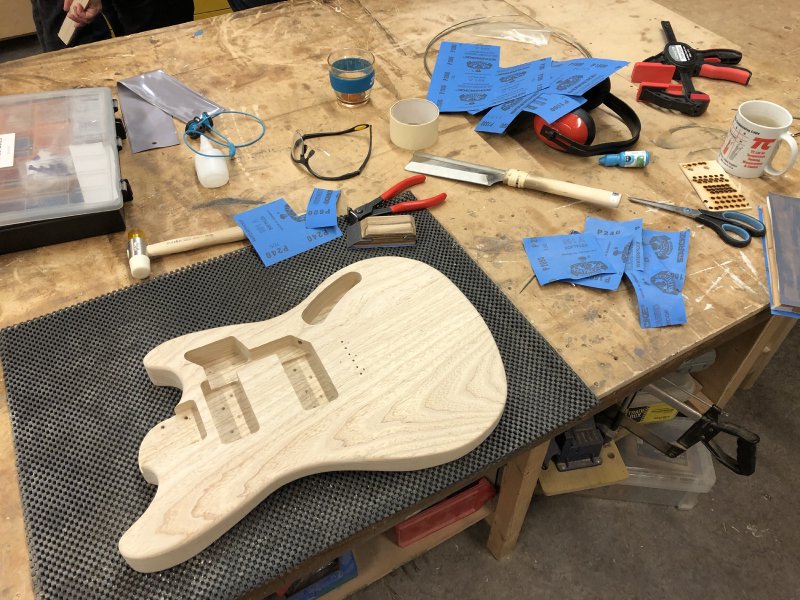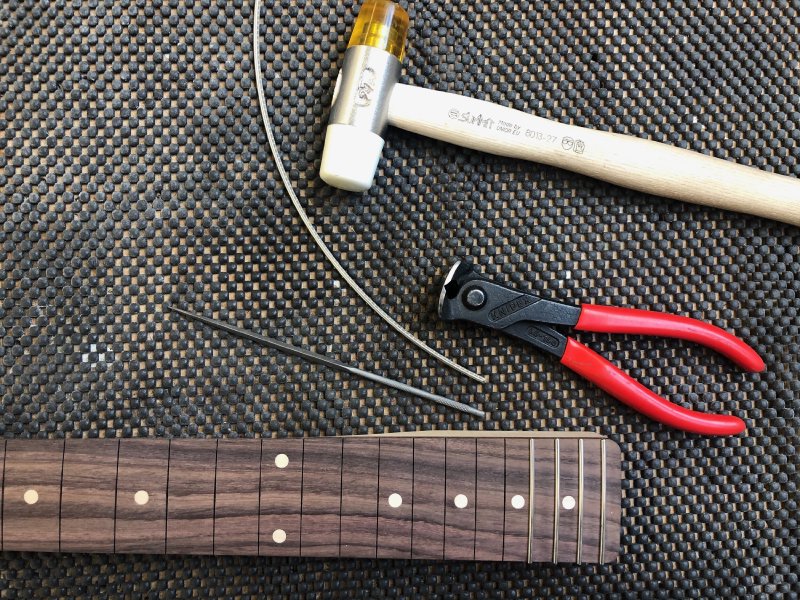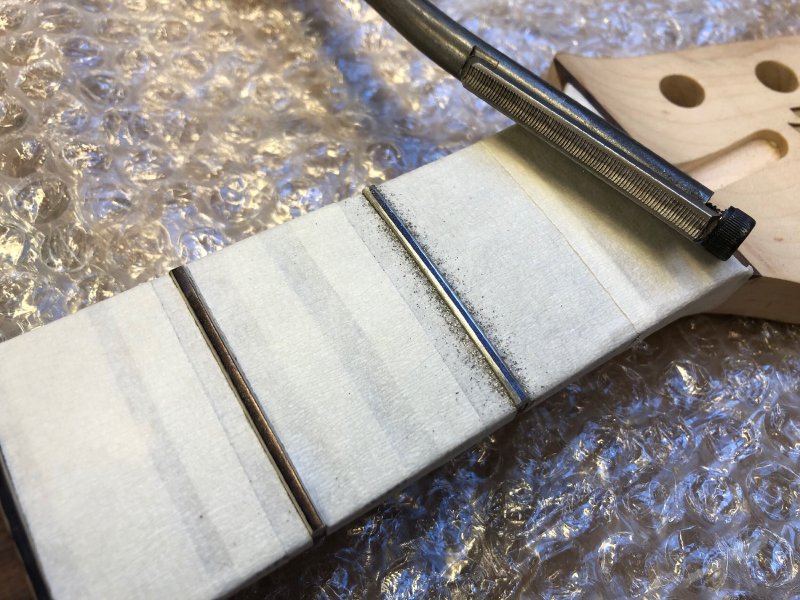A productive and frustrating week in the shop
11 Nov 2019
Tags: fretwork, the green tiger
This week has been both a productive and frustrating week in equal measure, as I managed to hit against some of the downsides of working in a shared workspace just as I’m trying to rush towards a deadline for this build. So I’ll start with the nice progress bits, and then talk a bit at the end about some of the flip sides to my normally enthusiastic stance of being in a community workshop.
This last week has been focussed on getting to the end of making the body and neck for commission #10 and getting on to the finishing stages. For the body that involved taking what looked like a finished body and sanding it to perfection.

I hate sanding, but this process you really want to get right, as the final finish here determines the first impressions that will be made on the instrument, no matter how well it plays. I start off at 240 grit, and work my way up through 600, 1000, 1500, and all the way up to 2000 grit, at which point the body is as smooth as silk. I also will then wet the body to make the grains stand up, after which it feels all furry, and so I go back through the grits again. The wetting will also help highlight any scratches that I missed.
As you go up through the grits you find tiny scratches that were not visible before, like these:

They’re really hard to spot, so you need good light for this process. But they will be very easy to spot once you start staining the wood, as the scratches will retain more stain, so it’s hugely important to be thorough here. If I was painting the guitar then I’d not need to be so pedantic here, as the paint will tend to fill very fine scratches like this, but if you want a nice natural wood finish you need to put in the time.
Once sanding is done, I can start staining. This customer for this commission wants a green guitar, so I use a green water-based stain, and I’ll typically use between 4 and 6 coats, until I get a consistent colour across the body and it reaches a colour depth I’m happy with.

What I love about staining ash is how the annual grain lines really soak up the stain, giving a nice striped look.
At the end of the week I’d done 4 coats, two a day basically. Between every other coat I’ll take some 2000 grit and gently rub it back as there will be some unevenness to the texture and some wood grain will have stood up again and need to be knocked back. Once I’m happy with this I can start oiling the body to give it a protective coat, which is essentially the same process to get up to 6 coats of oil.
The neck wasn’t quite at the finishing stage yet, as it still needed the frets installed, levelled, and polished, which itself is a full two days of work for me. But before I did that, I took time to roll over the edges of the fretboard:

I hadn’t done this on the first of my fully-hand built necks that I made for the tele deluxe that you may have seen me post here a few weeks ago, and having played that for a bit I find the edges a little annoying as I’ve made them a little too sharp with my new technique. Thus I took some time here to add a slight rounding over of the fretboard edges to make it more comfortable when gripped.
That done, I then spent the rest of the day getting the frets in, using a combination of hammer and press:

Despite rosewood being a popular fretboard material, this is only the second rosewood fretboard I’ve fretted, and the last one had wider pre-cut slots, so the technique I had to use was different from what I’ve done since I started to cut my own slots. With my own slots I make them quite narrow, 0.3mm, so that I don’t need to glue the frets in, making it easier to re-fret a decade or so down the line.
I’d always assumed that rosewood, being softer than say wenge or maple, would be easier to get the frets into the narrower slots, but actually that softness works against you, as the rosewood will happily start to squish if you push it the wrong way. Thus this fretboard took me longer to do than the last wenge one I made as I had to be that bit more precise, and I always thought the inverse would be true.
Frets in the neck is starting to look like the real thing. However, there’s till another full day of fret levelling and polishing to go.

As you press or hammer the frets into the slots they won’t all sit perfectly level with each other, so you have to level them to ensure the strings when pressed at one fret don’t hit a higher one further down the neck, and to minimise string buzz. To do this you essentially file all of them down to the same height using a mixture of a flat file and a long straight bar with sand paper on.
This done, you’ve now flattened the the frets, you have to re-crown them to make them round again to bring them to a point and so they are comfortable as you do slides and the like:

Once you’ve re-crowned them you then need to sand and polish them smooth. A lot of work, and there’s no short cuts here: but it’s the frets that make the notes, so you really do want to put in the effort.

I got to the end of the fretwork at the weekend, and so now I can do a final sanding pass on the neck now and then start oiling that (no staining the neck on this build). This means both body and neck should complete around the same time.
Unfortunately on both the above tasks I didn’t get as much done as I’d hoped due to issues arising from being in a community workshop, and I want to take a moment to reflect on these.
Now, I should preface this section by pointing out that no workshop environment is perfect, and there are positives and negatives to any setup. It’s also worth saying also that I’m convinced this would apply to any community workshop of this style, and isn’t Makespace specific. However, I spent a lot of time here talking about the positives of being in a community workshop, I feel it’s right that I also talk a bit about the negatives too.
In my mind the root cause in both incidents I had this week come down to the conflict between different community members having different expectations and experiences about the space. I am trying to make high quality instruments, I take time and care in what I do, and I want everything to be just right. I’m not alone in trying to do such projects at Makespace, but it’s worth acknowledging that the majority of people who use the space are actually just trying to bash something out quickly and are less interested in such quality. There’s absolutely nothing at all wrong with that, and such people have every right to use the Makespace workshop, but having projects with such different aims happing concurrently in the workshop has issues, due to differing expectations of the environment.
In the first incident I arrived at the workshop to sand the body down through the final stages and check there were no final scratches etc., and just as I got started another member came in to strip down some furniture, and despite there being reasonable amount of room, they set up to do this right next to me. Unfortunately within a few minutes I was being showered with dust as they took an orbital sander to their furniture and all my sand paper being blown around from the cooling exhaust of their sander. Despite being first there, I have no claim of exclusivity I can make, I just had to pack up and go home, losing a day of work - you can’t do precision work looking for fine scratches in a guitar body whilst having it covered in dust from someone else.
Could the other member have been more considerate and accommodating here? Yes, but only up to a point, as even if they’d gone to the other side of the room they were still producing large amounts of dust (though it’d just have been nice to not be showered in it and have to air blast all my stuff clean later). But as a community workshop there’s nothing wrong with what they did, and what they’re doing is acceptable in that broader context. It’s me with the exacting standards that is the outlier here.
The second incident was a bit more scary, but thankfully turned out okay in the end. Someone was in the workshop oiling the thing they made, and because they were trying to talk to someone else they didn’t pay due care and manage to splash what I was working on with their oil.

This was the result of a single drop of oil - getting oil onto wood when you don’t want it can be disastrous, and even just a single drop can have a large impact. Thankfully I managed to get rid of most of the staining that it caused using some white spirit (thanks Graeme for the tip), and the oil the person was using is of a similar style of oil to the one I’ll eventually use anyway what is left should blend it fine, but it caused me a lot of heart ache and one sleepless night as I worried about it. I’m already on the second neck build for this project due to my own mistake a couple of months ago, I really didn’t want to have to explain the need for a third neck.
I was absolutely livid of course, but the person wasn’t intentionally trying to ruin what I was working on, it was a genuine accident, so there was nothing to be gained by taking my anger out on them. Did they make a mistake? Yes, but mistakes do happen. Had they understood the consequences of what their lack of attention would potentially lead to they would no doubt have been more careful, but as someone less experienced at woodwork they didn’t understand the consequences.
Instead of being angry at my fellow member, I really need to be angry at myself for not anticipating the eventuality or letting myself get to a place where I have a deadline that doesn’t allow for things like this. Yes, it’s not ideal or fair or whatever, but it’s just how things are. I’m already working weekends to get this commission completed, so there’s no more time I can give to catch up with the loss of time these incidents have caused.
I find working in a community workshop has served me very well over the years - the leg up it’s given me in terms of experience and access to equipment is almost invaluable. But it comes with a set of costs that mostly I tend to gloss over, but occasionally, like now, get thrown into sharp relief. My real failure here, with my current deadline, was not to plan for these additional small delays that add up. I need to allow for the fact that people around me are not as invested in what I’m doing as I am and compensate for that as best I can.
Even if I could afford my own workshop (I can’t) then I’d not want to be shut off in my own shed somewhere as that would make what I do all the harder by not having helping hands I can turn to. If I had access to a more professional shared workshop then I’d most likely get my own isolated bench, which would be a lot better, but Makespace doesn’t have room for that sort of arrangement, and there isn’t another such workshop near me, so that’s not an option. I can either stick with what I have or give up building guitars.
So, what is the point of all this rant I’ve just had? I still think a community workshop is a good place to work on projects or even try to run a small business from. However, I do think you need to open your eyes up to the downsides as well as the upsides and ensure that you plan for when things go wrong beyond your control due to the fact you are surrounded by others not as interested in what you’re doing, as that will alway be a risk. For me the upsides far outweigh the downsides, but only you can tell if that’s true for your project.